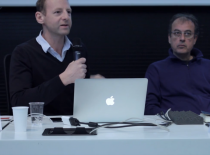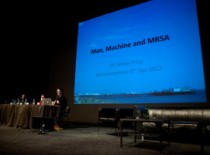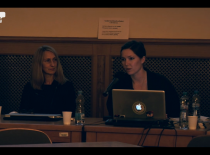Prague - December 8, 2012
Jennifer Kanary presents her paper within the panel Neurogenetic Media: From Research Tool to New Art Applications at International conference MutaMorphosis in Prague, Czech Republic.
Let’s suppose that madness lingers in all of us, that psychosis is a world of raw beauty and pure creation in which our thoughts and emotions are so powerful that they are experienced as real realities. We might venture into this world in search of narratives that help us make sense of things, to change realities that we are not in agreement with. But what if we venture so deep that our neurons do not find the way back to their usual patterns? We might stumble, stagger and panic as we no longer are able to bridge the communication gap between first person reality and third person reality. To get out of psychosis we need help.
What if future neurotechnology would be able to monitor and register real time psychotic experiences? This technology would provide a rare opportunity for interactive observation. Therapists would be able to ‘see’ and ‘hear’ the world as their patients do real time, allowing for more empathic treatment. For instance by learning that the color yellow is a trigger of fear, one can adjust treatment to which it takes the presence of the color yellow into consideration when a patient shows fear during therapy for ‘no apparent reason’. But just because one knows that the color yellow triggers fear, does not mean one understands why. A person in psychosis often does not have the ability to communicate their experience, so in order to make sense of psychotic narrative one might employ social group intelligence in which participants function as second person empathic resonators. Much like wikipedia is written by many people, the content of psychotic narrative could be mapped and interpreted with the informed associative skills of a social network. A new form of therapy might be devised: Cloud Therapy.
Labyrinth Psychotica is an interactive cinematic augmented reality artistic research PhD project that investigates such a future. In this art project a visitor is asked to wear a head mounted display and participate in a (fictional) medical experiment in which your mind will be uplinked to the mind of a girl named Jamie who is diagnosed with schizophrenia. You are asked to make observations and report back to Jamie’s therapist. Through this mind uplink you are able to see her memories, hear her voices, follow her chain of thoughts. At the same time her experiences seep into your reality, faces in your own world become distorted, you start to engage in behaviors that your world finds quite mad…Using the sensors of a Wii system, aspects of the narrative become interactive, the system starts to control you. In the cinematic experience you are forced to play The Movie Game, are taken to The Oracle, given the power over colors and get sucked into the black and white world of The Labyrinth.
Labyrinth Psychotica might be considered as a form of ‘Digital LSD’, a type of do-it-yourself-psychosis-kit’, a tool of empathy, a prosthesis for our imagination in situations that our minds find hard to grasp. For MutaMorphosis Labyrinth Psychotica will show a recording of the experience and present reflections on the role of the artist as an intuitive neuroscientist with reference to the work of Prof S. Zeki. The artist and the participant as second person empathic resonator’s with reference to the work of F. Varela. And the art experience as a form of ‘active extended mind’ with reference to the work of A. Clark and D. Chalmers. What if in the future we would not only be able to follow a persons experience, but also shift it? Would you dare to uplink your mind? Would you give consent to others entering yours?
- Tags:




 Copyright © 2024 ARTISTTALK. All Rights Reserved.
Copyright © 2024 ARTISTTALK. All Rights Reserved.
0 Comments
You can be the first one to leave a comment.